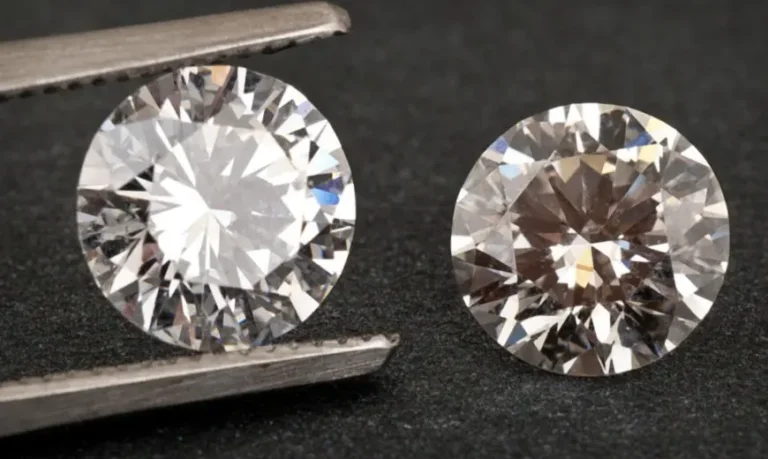When you look at a sparkly diamond, you might be wondering where it comes from. Natural gem formed deep inside the Earth over millions of years, or a lab-grown stone crafted in a matter of weeks? Thanks to technological advances, it’s becoming harder and harder to tell the difference between mined and synthetic diamonds at least with the naked eye. But there are ways to figure out a diamond’s provenance. Whether you’re an inquisitive consumer, a diamond aficionado or looking to purchase a diamond, knowing how to distinguish lab-grown from mined diamonds can be priceless. In this article you will find out about the top techniques to find out a diamond’s real value and what to depend on.
Understanding the Differences Between Lab-Grown and Mined Diamonds
Physical Properties
Their chemical make-up is the same as mined diamonds: they are pure carbon arranged in a crystal form. But they do show subtle differences in their growth patterns. Mined diamonds take millions of years to grow deep in the Earth, lab-grown diamonds are made in controlled settings in a matter of weeks. Experts, when comparing prices and lab-grown alternatives to, for example, Rare Carat 55 Carat Emerald Cut Diamond Prices and Value | Rare Carat® looks for the telltale signs of artificial growth.
Value and Rarity
Because they come straight from the earth, mined diamonds are often viewed as more valuable, and there is some level of scarcity associated with them. Trillion diamonds have become quite the conversation pieces, but even more than that formidable 55 carat emerald cut diamond prices are rare! And likewise, Rare Carat 56 Carat VS1 Diamond Prices and Value | Rare Carat® indicate the premium associated with major natural gemstones of superior quality. On the other hand, diamonds grow in laboratories are considerably cheaper, and Rare Carat 6 Carat Emerald Cut Diamond Prices and Value are paramount.
Environmental and Ethical Considerations
Lab-grown diamonds often have a smaller environmental footprint than diamond-mining operations. Lab-grown diamonds also help eliminate the guilt associated with mining practices or blood diamonds. Yet some argue that responsible diamond mining can mean vital economic support for developing areas.
6 Carat Emerald Cut Diamond Prices: Mined vs. Lab-Grown
In your comparison of prices for 6 carat emerald cut diamonds, a significant price differences exists between mined and lab-grown stones. Rare Carat 6 Carat Emerald Cut Diamond Prices and Value | Rare Carat® Another high-quality option to consider are lab-grown diamonds, which are typically 30-40% cheaper than mined versions.
Mined Diamond Prices
Natural mined 6 carat emerald cut diamonds are exceedingly rare and very expensive. And you’ve probably also heard that color, clarity and cut quality determine cost. For example, a high quality VS1 clarity stone may compare favorably to Rare Carat 56 Carat VS1 Diamond Prices per carat.
Lab-Grown Diamond Prices
Lab-created diamonds provide a more economical option of the same size and quality. Prices of 6 carat lab-grown emerald cuts are much lower than mined gems, though still tremendous. However, they don’t appreciate in value like natural diamonds.
Price Comparison
For comparison, mined gemstones and diamonds Rare Carat 55 Carat Emerald Cut Diamonds, show prices in the millions. In comparison, a similar 6 carat emerald cut created in the lab may sell for tens of thousands, making it an alluring option for those with thin wallets who want plenty of sparkle for their money.
Spotting the Signs: How to Identify a Lab-Grown Diamond
Visual Inspection
Although lab-grown and mined diamonds can look the same to the naked eye, there are slight differences that trained professionals can find. Gemologists will use specialized equipment to analyze the crystal structure and growth patterns. The accelerated crystallization process can leave minor differences in crystal structure, but such differences are generally not visible.
Certification and Origin
Reputable diamond sellers offer certificates describing a stone’s characteristics, including its origin. These documents, which come from gemological laboratories, verify if a diamond is natural or lab-grown. For Rare Carat 56 Carat VS1 Diamond Prices, always ask for and examine accompanying certification.
Advanced Testing Methods
Gemological laboratories use advanced methods to distinguish between natural diamonds and lab-grown ones. Those include spectroscopy and X-ray analysis, which can show the distinctive chemical compositions and internal structures of each type. This is all even more important when considering Rare Carat 6 Carat Emerald Cut Diamond Prices and Value, which often can be thousands of dollars different for natural or lab-grown stones, and you want to be sure that your investment is going to be well worth what you are paying for it.
Conclusion
And finally, our final thought: To tell if a diamond is lab created or mined, you need a sensitive 4-step approach. Visual inspection alone can be misleading, but advanced gemological techniques such as spectroscopy and microscopy can identify telltale differences. Only reputable jewelers and gemological laboratories have the equipment and technical following to make proper assessments. As a consumer, it’s a good idea to request certification and to ask detailed questions about a diamond’s origin. As lab-grown diamonds continue to become more common, keeping up with identification methods is useful to know. Whether you choose natural or lab-created stones, knowing how to tell the difference allows you to buy diamonds with confidence and knowledge.
Also Read-The Ultimate Guide to Playtech Slots
